About Septic Systems
Absorption Field (Leach Field)
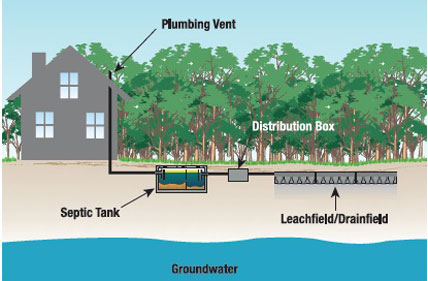
The area to which effluent (wastewater) is distributed for infiltration to the soil by means of a network of pipes. This may be a system of trenches partially filled with a bed of washed gravel into which perforated or open joint pipe is placed. The discharge from the septic tank is distributed through these pipes into the trenches and surrounding soil. The subsurface absorption field must be properly sized and constructed to assure satisfactory operation and a long life. Also see: Gravelless Leach Field.
Aerobic Units
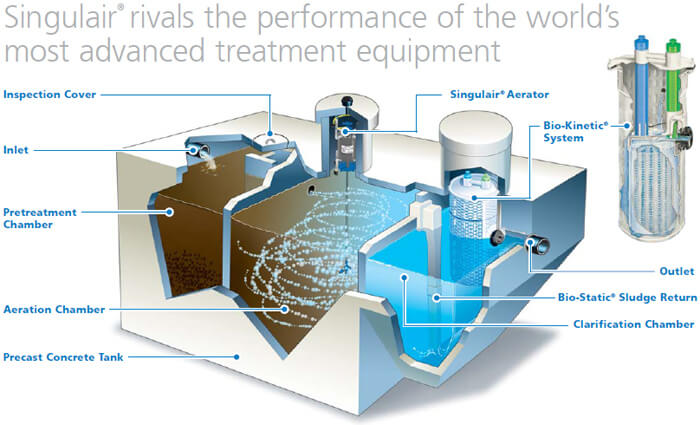
Watertight compartment with a pump, air compressor, or other device to inject air into the sewage in the compartment. The injected air stimulates multiplication of aerobic bacteria and results in improved biological decomposition of organic matter. Aerobic units are generally classified Class I or II in accordance with the National Sanitation foundation (NSF) Standard 40.
Anaerobic Wastewater Process

Three step bacterial respiration process that occurs in the absence of oxygen. Heterotrophic bacteria (which do not require oxygen) oxidize material to form CO2 and water. The process is more complex than described here, involving also autotrophic bacteria and chemical processes in three stages: acid fermentation, acid regression, and alkaline fermentation.
Baffle
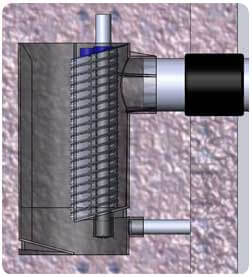
Flow deflecting device used in septic tanks to inhibit the discharge of floating solids, reduce the amount of settle able solids that exit, and reduce the exit velocity of the wastewater.
Biomat
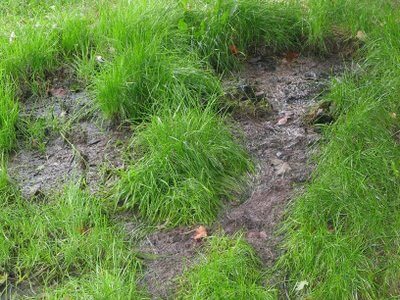
Bacterial slime layer in the soil below the leach field and around other wastewater disposal systems. Critical septic effluent treatment occurs in the biomat.
Biochemical Oxygen Demand (BOD)
The amount of oxygen necessary to permit microbes (within a septic treatment system) to consume organic material in wastewater. BOD is normally expressed as BOD-5 or five-day BOD, the amount of oxygen consumed by microbes (for example within a septic treatment systems) over a five day period, for a given volume of wastewater. BOD is used to describe the quality of untreated wastewater, or in other words, to determine the amount of treatment that wastewater will require before it can be discharged to the environment.
Conventional Septic System
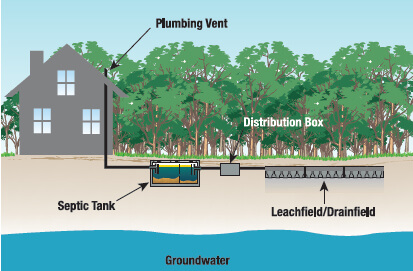
Traditional onsite wastewater disposal system which uses a (water-tight) septic tank and leach field or drain field buried in the original site soils.
Curtain Drain
Subsurface drain designed and constructed to control groundwater and surface water intrusion into the area of the sewage system.
Deep Hole Test
A hole, 6+ feet deep to assure that uniform soil and site conditions prevail.
Dosing System
System using mechanical means (bell siphon, tipping bucket, float valves) or electrically controlled means (electric pumps and pressure distribution systems) to first accumulate septic effluent in a dosing chamber or “distribution chamber” and then, when a specified volume of effluent has been collected, move that “dose” of effluent to the soil absorption system (sand filter bed, drain field, or other system) for final treatment, filtering, and dispersal.
Distribution Box
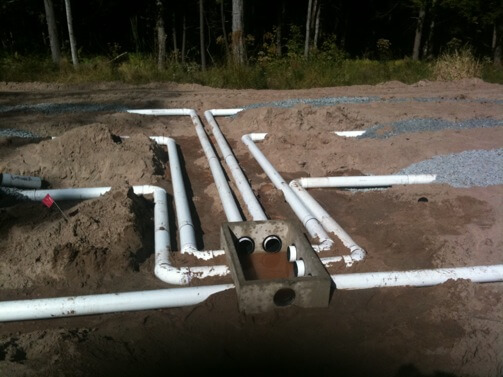
Distributes the effluent from the septic tank evenly to the absorption field or seepage pits. It is important that each trench or pit receive an equal amount of flow. This prevents overloading of one part of the system.
Drop Box
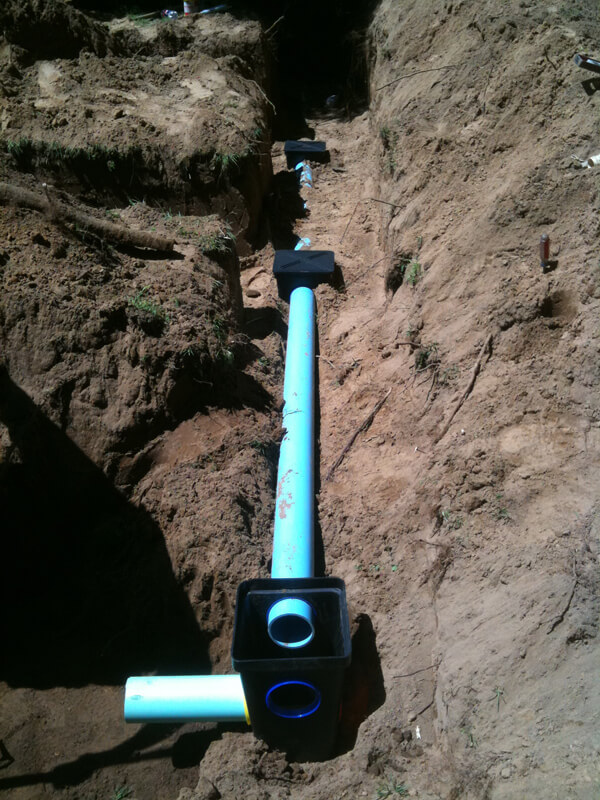
Distributes the effluent from the septic tank to an absorption field located on slopes.
Drywell (Seepage Pit)
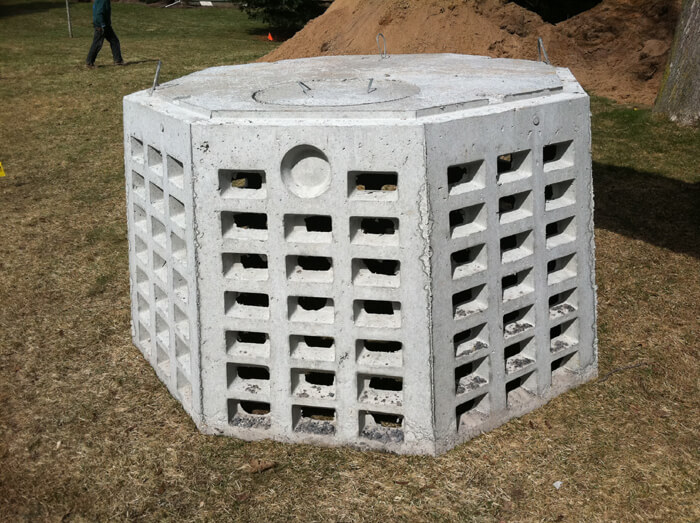
An underground leaching structure generally installed in sandy or gravel-type soils and used in place of a leach field. Like the absorption field, the dry well (seepage pit) must be properly sized and constructed. While seepage pits normally require less land area to install, they should be used only where absorption fields are not suitable and well water supplies are not endangered.
Dye Test System
Septic dye tests involve placing a special florescent dye into a plumbing fixture or directly into the septic tank. It is a colored indicator that can identify water as having come from the fixture where the dye was introduced. It’s the volume of water introduced into the system that forms the actual “test”. If waste water is coming to the surface (an unsanitary condition indicating serious septic failure) one may see dye in that surface water.
Effluent Pump
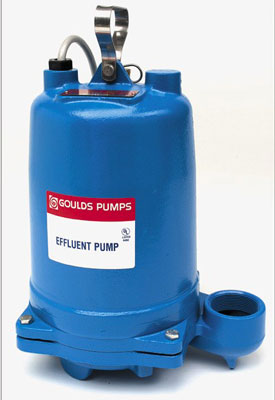
Pumps wastewater (no solid wastes) at pressure to a treatment system. A septic tank would precede this to collect the solid wastes. The effluent (wastewater) flows from the septic tank to a second tank, where an effluent pump will pump the wastewater through a force main uphill to a private onsite wastewater treatment system.
Fats, Oils, Grease
Component of sewage which forms the floating scum layer in septic tanks.
Force Main
Smaller diameter (comparatively) sewage waste line used to move solid waste output from a grinder or effluent pump to a wastewater treatment area. Grinder or effluent pumps are used with “force main” septic systems to move waste products uphill to a private onsite wastewater treatment area or in larger installations, to move sewage to a centralized treatment facility. Force mains used to carry sewage prepared by a grinder or effluent pump will generally be a smaller diameter than waste lines which work by gravity.
Gravelless Leach Field
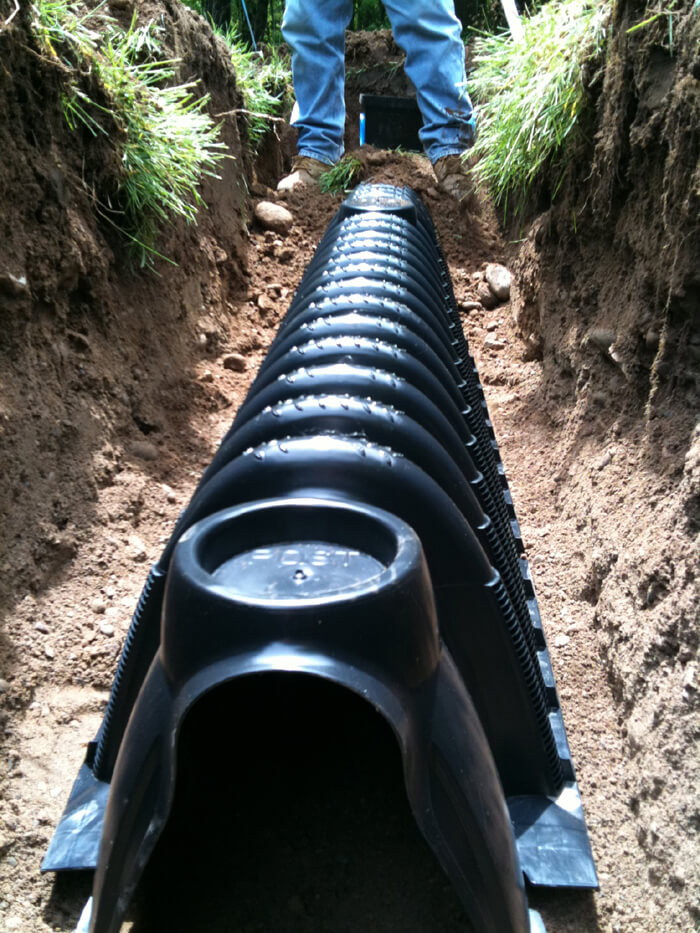
A system of trenches using leaching chambers rather than traditional corrugated pipe and stone, allowing increased soil infiltration. The discharge from the septic tank is distributed through these chambers into the trenches and surrounding soil. The subsurface absorption field must be properly sized and constructed to assure satisfactory operation and a long life.
Grinder Pump
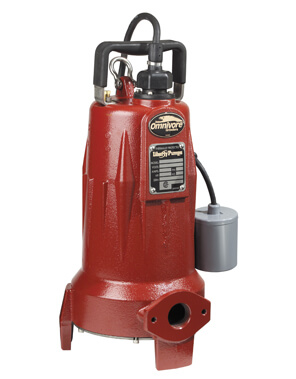
Macerating pump capable of grinding up sewage, including the solid waste, so the waste product can be pumped at pressure to a treatment system. Grinder pumps are used with “force main” septic systems to move waste products uphill to a private onsite wastewater treatment facility or in larger installations, to move sewage to a centralized treatment facility.
Holding Tank
Septic Holding Tank Systems use a sealed tank to hold waste and wastewater until the tank can be pumped out by a septic pumping company. Holding tanks have no drains and must be pumped.
Leach Field (Leach Bed, Soil Absorption System, Drain Field)
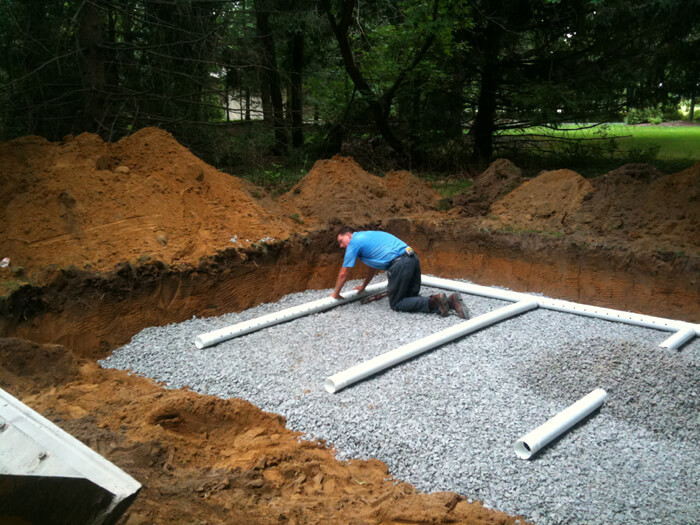
In drainfields, the drain rock-original soil interface at the bottom of the trench; in mound systems, the gravel-mound sand and the sand-original soil interfaces; in sand-lined trenches/beds (sand filter), the gravel-sand interface and the sand-original soil interface at the bottom of the trench or bed.
Perc Test (Soil Percolation Test)
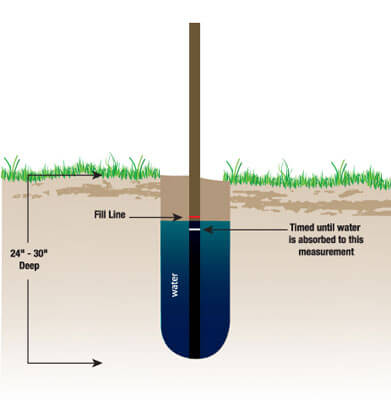
A test hole is dug 24 to 30 inches below grade in the area to be used as a drain field. The test results are indicative of the ability of a soil to absorb treated wastewater. Water is poured into the hole and the rate at which soil absorbs the water by noting the time that it takes for the level of water in the hole to drop one inch. These tests are used to determine the ability of a soil to transmit wastewater effluent through the soil. The soil percolation rate is the amount of time water takes to move through the soil, measured in minutes per inch. Finer textured soils have slower percolation rates; it takes longer for water to drain from a test hole. These soil types need larger drain fields than soils with faster percolation rates.
Pumping Chamber (Pump Station)
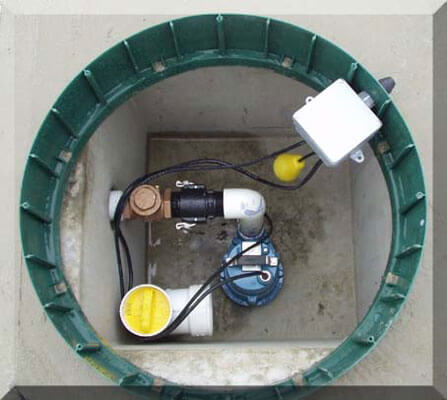
A tank or containment source which contains a pump, floats, and volume for storage for effluent. When the effluent reaches a certain level the pump is activated and the wastewater is sent through the force main to the wastewater treatment area.
Raised Bed Septic Systems
Wastewater absorption trench system which has been constructed in soil-fill material which has been placed on top of the natural soil on a building lot. Raised septic bed systems make at least partial use of existing soils for wastewater treatment.
Sand Bed Filter Septic Systems
In a sand filter septic system, the septic tank or aerobic unit effluent is intermittently spread across the surface of a bed of sand through a network of distribution lines. A biomat forms in the upper 9-18″ of sand to perform the actual treatment function. Collector pipes beneath the filter collect treated effluent after it has passed through the sand.
Septic System
On-site septic disposal systems are common in rural areas, and increasingly in suburban and urban areas, where public sewage treatment systems do not exist. A complete modern septic system consists of a buried septic tank, usually 1000 to 1500 gallon capacity, that holds the solid waste from a home’s plumbing waste drains, and a septic drain field, that distributes the waste water to the ground where it disperses through the soil or evaporates. In area where poor soil conditions, or high ground water exist make traditional septic systems unfeasible, technological developments have made it possible for onsite systems to function properly. They treat wastewater and solids more completely and making it possible for the effluent to enter the ground, where final treatment occurs using the naturally occurring bacteria found there. Some examples are: Presby Environmental AES, Aquaworxs Remediators , Infiltrators, and Norweco ATU’s.
Septic Tank

An underground sedimentation tank in which sewage is retained for a short period while it is decomposed and purified by bacterial action. The organic matter in the sewage settles to the bottom of the tank, a film forms excluding atmospheric oxygen, and anaerobic bacteria attack the solid matter, causing it to disintegrate, liquefy, and give off gases. The gases are discharged from a vent and the liquids overflow through an outlet into a disposal field where they can leach into the soil.



